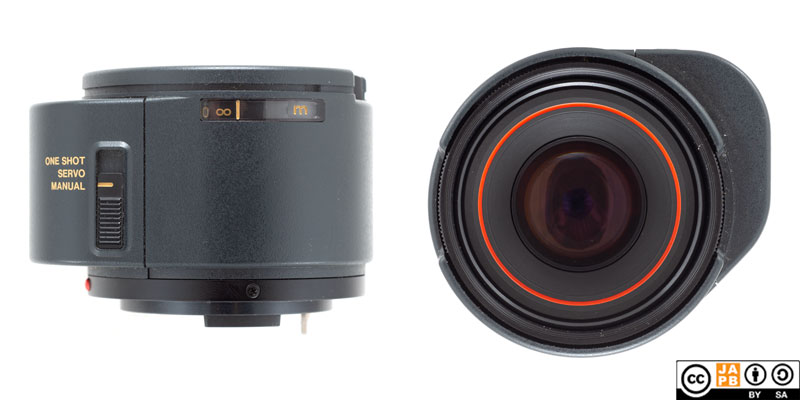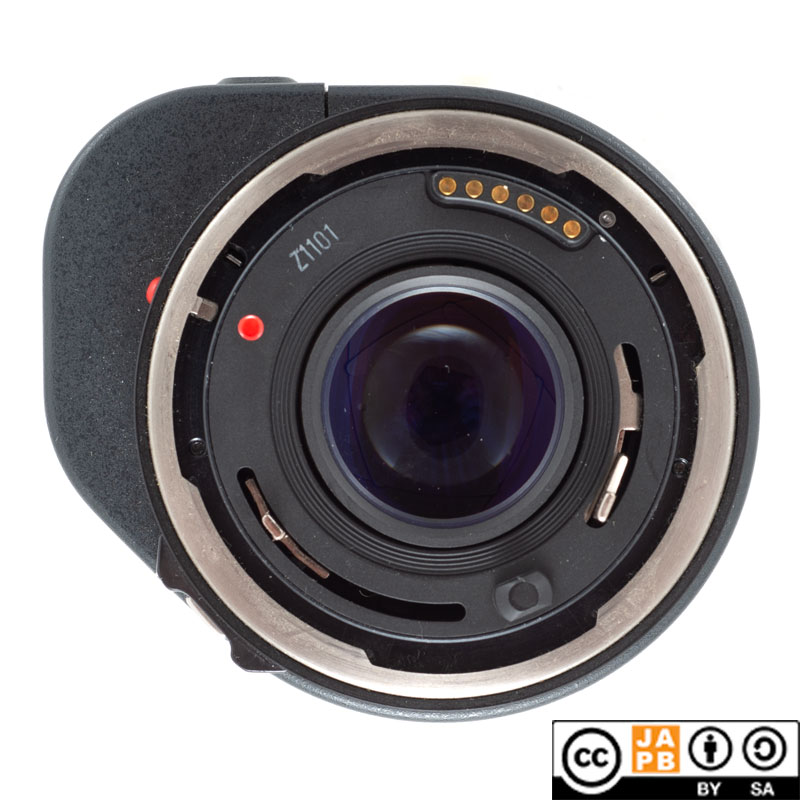Pekka Buttler, 10/2025

Specifications
The table below summarises the lens’ key specifications (measurements based on pictured sample):
| Brand: | Canon | Lens name | AC 50 mm 1:1.8 |
| Focal length(s)1 | 50 mm | Angle-of-view2 | 46 ° |
| Maximum Aperture | f/1.8 | In Production | 1985–1986 |
| Lens mount | Canon AC | Subfamily (if applicable) | N/A |
| Length3 | 49,0 mm | Diameter4 | 78,8 mm |
| Filter ring diameter | 52 mm | Weight | 212 grams |
| Lens element count | 6 | Lens group count | 4 |
| Aperture blades (S/R/C)5 | 5 S | Focus throw | 170 ° |
| Minimum focusing distance (measured) | 58,5 cm | Maximum magnification (measured) | 1:9,6 |
| Has manual aperture ring | NO | Has Manual focus ring | YES |
| Aperture mechanism type | Steered by camera | Aperture click stops 6 | N/A |
Further notes:
• In the mid-1980s every mainstream camera manufacturer was busy making plans to offer increased autofocusing capabilities. While Canon was busy developing its soon to be released EOS system, they nevertheless decided to jerry-rig their existing camera system (The Canon FD system) to offer AF capabilities. This is the origin story of the Canon T80 camera that canon introduced 1985.
• If you took a Canon T80 camera and put any Canon FD compatible lens on it, it would work pretty much similarly to Canon’s other contemporary cameras (the T70 and T50), with the added bonus that the T80 had focus assist (small LED indicators would help you nail focus). Focus assist was nothing revolutionary and Canon had already introduced that functionality in 1982 with the Canon AL-1 camera.
• However, together with the T80, Canon also launched a trio of lenses: The AC 50/1.8 (this lens) as well as AC35-70mm f/3.5–4.5 and the AC75–200mm f/4.5. These were not your regular FD lenses, instead they were marked ‘AC’ and offered autofocus capability when mounted on the T80 camera.

• In effect, these ‘AC’ lenses were implementing an extension of the Canon FDn mount, adding 6 electronic contacts that would used to communicate between lens and camera and that would power the autofocus motor that was housed in the (rather conspicuous) bulge at the side of the lens.
• In a definite break with tradition (and as an omen of what was to come), this lens does not have an aperture control ring as that functionality is entirely driven by the camera.
History of Canon AC lenses
Feel free to browse the JAPB article on the Canon AC mount for all the details. Below is an outline of the position of the Canon FD mount in Canon’s development trajectory:
• 1959–1963: R-mount. Canon’s first SLR lens mount. Breech lock-type mount with aperture semi-automation (camera is able to stop down lens for taking the shot, but lens needs to be opened up by user action) .
• 1964–1969: FL-mount. Breech-lock type mount, physically similar mount as Canon R-mount, but camera-to-lens communication linkages somewhat different. Cannot communicate selected aperture to body (stop-down-metering only).
• 1970–1978: FD-mount. Breech-lock mount. FD lenses compatible with FL-cameras and vice versa. Manual focus lenses that communicate aperture information to camera, hence opening the door for automatic exposure (both shutter priority and aperture priority possible)
• 1979–1986: new FD-mount (a.k.a. FDn). Bayonet mount, backwards compatible with FL and FD mounts. Otherwise, as FD mount.
• 1985–1986: AC-mount. Short-lived extension of the FDn mount to facilitate autofocus on compatible cameras and lenses.
• 1987–today: EF-mount. Electronically controlled autofocus lenses that use an internal focusing motor. Compatible with previous mount lenses only using an adapter with optics.
Related versions
In terms of optical designs, this lens is closely related to the Canon FDn 50 mm f/1.8 [data sheet].
Adapting
Adapting to SLRs: Besides mounting this lens on the Canon T80 it was intended to be used with (“Go for the genuine 1980s, bleeding edge AF experience!”), there are also some other options for using this lens (or any of the other Canon AC lenses).
Looking at the Canon AC lens’ mount (Essentially it looks like an new FD mount with some added electronic contacts) you might be thinking “So I should be able to mount this on any FD body, and as long as that body is designed so that I could just put the lens’ aperture ring in ‘auto’ and go shooting this lens should work also…” And you would be justified in making this assumption.
Indeed, if you can manage with a lens that looks like a weird 80s Sci-Fi product; that forces you to always leave aperture control to the camera body and that is so designed for AF that the usability of the manual focus ring is by far the worst I’ve seen (and I’ve seen many), then you can mount this lens on any Canon FD camera that is centred of shutter priority or program AE7. “Why would you bother?” is, however, a justified question.
Due to the inability to control the lens’ aperture through an aperture ring, you cannot mount the Canon AC lenses on any other SLRs or dSLRs8.
Adapting to mirrorless: This is – again – an entirely different ball-game. You can mount a Canon AC lens on any mirrorless camera using your average Canon FD lens adapter. You can even use that adapter’s control ring that you would normally use to engage the aperture ring’s manual mode to exert a modicum of control on the lens’ aperture, but it’s a clunky affair and does not give you precise control. If you have especially nimble fingers you can even manually focus the lens.
But unless you gain a lot of joy from circumventing limitations that might slow down a lesser lens hacker, the question is: why bother.
Obviously I did, and am offering some images below (Sony ⍺7R2, Canon AC 50/1.8, no-name FD->NEX adapter, ACR default conversion, Resize to 2K, save as JPG). While the AC 50/1.8 is decently sharp and my copy seems to have seen very little use, I am not going to change that. It simply is too unwieldy to use.


Footnotes
- Focal length is (unless stated otherwise) given in absolute terms, and not in Full-frame equivalent. For an understanding of whether the lens is wide/tele, see ‘Angle-of-view’. ↩︎
- Picture angle is given in degrees and concerns the diagonal picture angle. Rule of thumb:
> 90 ° ==> Ultra-wide-angle
70–90 ° ==> Wide-angle
50–70 ° ==> Moderate wide-angle
40–50 ° ==> ‘Standard’ or ‘normal’ lens
20–40 ° ==> Short tele lens
10-20 ° ==> Tele lens
5-10 ° ==> Long tele lens
< 5 ° ==> Ultra-tele lens ↩︎ - Length is given from the mount flange to the front of lens at its shortest. ↩︎
- Diameter excludes protrusions such as rabbit ears or stop-down levers. ↩︎
- S=straight; R=rounded; C=(almost)circular at all apertures. ↩︎
- Numbers equal aperture values on aperture ring; • intermediate click; – no intermediate click. ↩︎
- That list includes at least: AE-1, A-1, AE-1 Program, AL-1, T50, T70, T80 and T90. Please note that I have not tested functionality on all. ↩︎
- Theoretically it could be possible to make a Canon FD to Four thirds adapter with aperture control, but if there are such adapters, I haven’t seen any. ↩︎